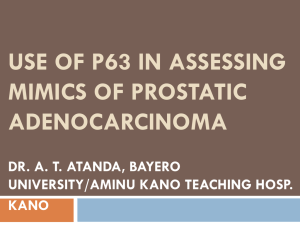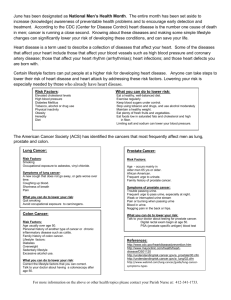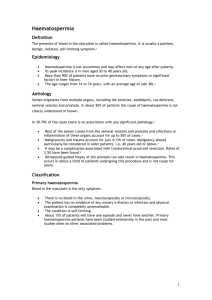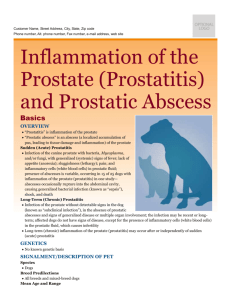CANINE PROSTATIC DISEASE
advertisement
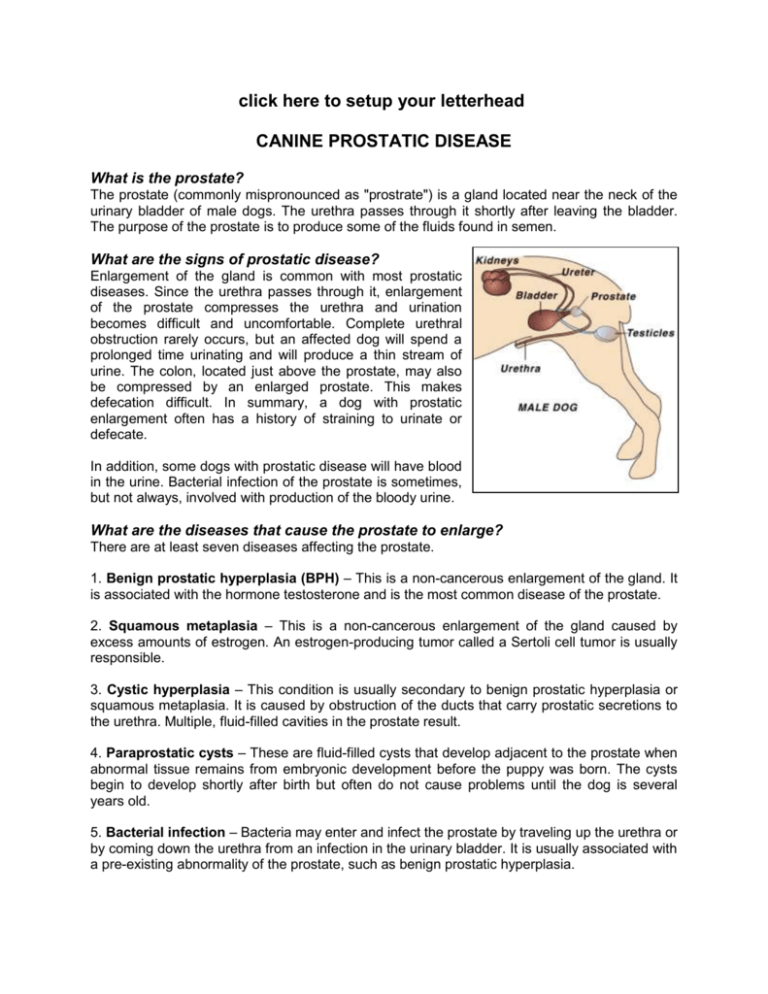
click here to setup your letterhead CANINE PROSTATIC DISEASE What is the prostate? The prostate (commonly mispronounced as "prostrate") is a gland located near the neck of the urinary bladder of male dogs. The urethra passes through it shortly after leaving the bladder. The purpose of the prostate is to produce some of the fluids found in semen. What are the signs of prostatic disease? Enlargement of the gland is common with most prostatic diseases. Since the urethra passes through it, enlargement of the prostate compresses the urethra and urination becomes difficult and uncomfortable. Complete urethral obstruction rarely occurs, but an affected dog will spend a prolonged time urinating and will produce a thin stream of urine. The colon, located just above the prostate, may also be compressed by an enlarged prostate. This makes defecation difficult. In summary, a dog with prostatic enlargement often has a history of straining to urinate or defecate. In addition, some dogs with prostatic disease will have blood in the urine. Bacterial infection of the prostate is sometimes, but not always, involved with production of the bloody urine. What are the diseases that cause the prostate to enlarge? There are at least seven diseases affecting the prostate. 1. Benign prostatic hyperplasia (BPH) – This is a non-cancerous enlargement of the gland. It is associated with the hormone testosterone and is the most common disease of the prostate. 2. Squamous metaplasia – This is a non-cancerous enlargement of the gland caused by excess amounts of estrogen. An estrogen-producing tumor called a Sertoli cell tumor is usually responsible. 3. Cystic hyperplasia – This condition is usually secondary to benign prostatic hyperplasia or squamous metaplasia. It is caused by obstruction of the ducts that carry prostatic secretions to the urethra. Multiple, fluid-filled cavities in the prostate result. 4. Paraprostatic cysts – These are fluid-filled cysts that develop adjacent to the prostate when abnormal tissue remains from embryonic development before the puppy was born. The cysts begin to develop shortly after birth but often do not cause problems until the dog is several years old. 5. Bacterial infection – Bacteria may enter and infect the prostate by traveling up the urethra or by coming down the urethra from an infection in the urinary bladder. It is usually associated with a pre-existing abnormality of the prostate, such as benign prostatic hyperplasia. 6. Prostatic abscess – This is a progressive form of a bacterial infection. If the ducts that drain the prostate become obstructed, bacteria are trapped in the prostate and form a walled-off site of infection known as an abscess. 7. Prostatic cancer – This form is much less common in the dog than all of the others. It may be associated with hormones from the testicles, adrenal glands, or pituitary glands or without any association with hormones. How is prostatic disease diagnosed? The first step in diagnosis is to determine if the prostate is enlarged. This is done by feeling its size either through the abdominal wall or through the rectal wall. Enlargement may be confirmed by radiographs (x-rays) or an ultrasound examination. Because there are so many diseases of the prostate, it is necessary to perform several tests to tell them apart. These tests include cultures of the dog's urine, a microscopic examination of the cells in the urine, and a microscopic examination of the cells in prostatic fluid or in the prostate itself. Samples of prostatic fluid are recovered by passing a urethral catheter to the level of the prostate and massaging the prostate to "milk" fluid out of it. Samples of prostatic cells are obtained by aspiration or biopsy via a needle that is either passed through the body wall or passed through the rectal wall. If the prostate is greatly enlarged, it can be aspirated or biopsied through the body wall; otherwise, an approach through the rectal wall is necessary. An aspiration sample is taken through a very small bore needle and only recovers a few cells. Sometimes this is adequate for analysis; other times it is not. A needle biopsy sample is obtained through a large bore needle that is passed into the prostate by ultrasound guidance. A biopsy sample recovers a piece of tissue that permits a pathologist to make a more accurate diagnosis. How are diseases of the prostate treated? 1. Diseases involving primary or secondary bacterial infections are treated with aggressive antibiotic therapy. Because it is difficult for antibiotics to penetrate into the prostate, treatment for several weeks to months is usually necessary. Since most of the infections are secondary to another disease, treating the infection is only part of the overall treatment. 2. Diseases associated with excessive hormone levels include benign prostatic hyperplasia, cystic metaplasia, and cystic hyperplasia. Since testosterone and estrogen are both formed in the testicles, neutering is generally an effective treatment for these conditions. The prostate will generally return to normal within one month after surgery. 3. Paraprostatic cysts and prostatic abscesses require major abdominal surgery to drain and remove. 4. Prostatic cancer does not respond well to any currently used form of treatment. If it is associated with an excess of a hormone, neutering may be beneficial; however, most are not and spread to other parts of the body. The prognosis for these is usually poor. This client information sheet is based on material written by Ernest Ward, DVM. © Copyright 2005 Lifelearn Inc. Used with permission under license. February 16, 2016


